Implants remain the most definitive and reliable method of calf augmentation. While fat injections may benefit select patients, calf implants consistently provide a more predictable and effective outcome. Like other extremity implants, calf implants are linear in design, with length greater than width, and are placed in a north–south orientation. The incision is favorably positioned within the popliteal fossa (behind the knee), taking advantage of a natural skin crease under a movable joint.
Muscle Anatomy and Aesthetic Goals
The gastrocnemius muscle has two distinct heads, or bellies:
-
Medial gastrocnemius (larger head): Visible from the front, it has the most significant impact on calf contour and overall leg aesthetics.
-
Lateral gastrocnemius (smaller head): Less apparent from the front, with projection primarily toward the back.
Depending on the desired result, some patients may only require augmentation of the medial head, while others may need both medial and lateral augmentation. In certain cases, two implants per leg may be required to enhance all four muscle heads.
Key Nerve Considerations
Proper placement requires awareness of the surrounding nerve anatomy:
-
Sural nerve:
A sensory nerve running between the gastrocnemius heads, supplying sensation to the back of the leg, outer ankle, and lateral foot. It lies outside the fascial covering of both muscles. As long as dissection remains within the muscle fascia and does not cross the midline, the sural nerve is protected. Two separate incisions—one for each muscle belly—ensure direct access and reduce risk of injury.
-
Common peroneal nerve:
A mixed motor and sensory nerve responsible for foot dorsiflexion and eversion. It travels through the popliteal fossa and around the posterior fibular neck, dividing into superficial and deep branches. In some patients, its course can be very close to the incision for a lateral calf implant. Careful blunt dissection is essential to identify and preserve it. If encountered, the implant should be passed medial to the nerve, with gentle retraction to avoid tension.
Technical Pearls
-
Implants, if properly placed in the gastrocnemius fascia, will not seen at the incision level or near the incision. They must be placed low enough to prevent high riding near the peroneal nerve, which can lead to postoperative compression during knee flexion. (as seen in this picture) Besides good positioning it may be necessary to downsize the impant to ensure safe positioning.
-
For medial implants, maximize aesthetic impact by placing them as medially as possible.
-
For lateral implants, keep them posterior to avoid impinging on the peroneal nerve.
Summary
Calf implants provide consistent, long-term improvement in leg contour, but success depends on meticulous attention to anatomy—particularly nerve pathways. Proper incision placement, careful dissection, and respect for nerve structures are essential for both safety and optimal aesthetic outcomes.
Dr. Barry Eppley
World-Renowned Plastic Surgeon

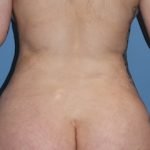
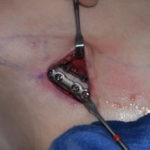
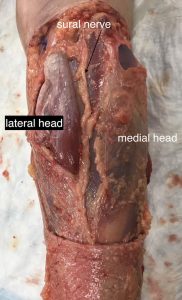
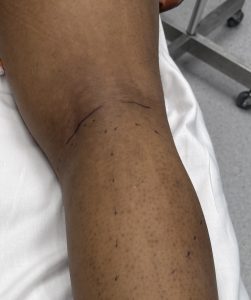 A sensory nerve running between the gastrocnemius heads, supplying sensation to the back of the leg, outer ankle, and lateral foot. It lies outside the fascial covering of both muscles. As long as dissection remains within the muscle fascia and does not cross the midline, the sural nerve is protected. Two separate incisions—one for each muscle belly—ensure direct access and reduce risk of injury.
A sensory nerve running between the gastrocnemius heads, supplying sensation to the back of the leg, outer ankle, and lateral foot. It lies outside the fascial covering of both muscles. As long as dissection remains within the muscle fascia and does not cross the midline, the sural nerve is protected. Two separate incisions—one for each muscle belly—ensure direct access and reduce risk of injury.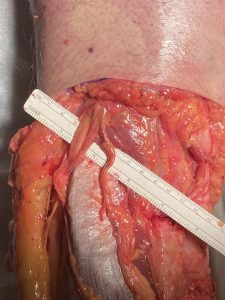
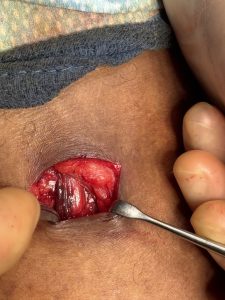 A mixed motor and sensory nerve responsible for foot dorsiflexion and eversion. It travels through the popliteal fossa and around the posterior fibular neck, dividing into superficial and deep branches. In some patients, its course can be very close to the incision for a lateral calf implant. Careful blunt dissection is essential to identify and preserve it. If encountered, the implant should be passed medial to the nerve, with gentle retraction to avoid tension.
A mixed motor and sensory nerve responsible for foot dorsiflexion and eversion. It travels through the popliteal fossa and around the posterior fibular neck, dividing into superficial and deep branches. In some patients, its course can be very close to the incision for a lateral calf implant. Careful blunt dissection is essential to identify and preserve it. If encountered, the implant should be passed medial to the nerve, with gentle retraction to avoid tension.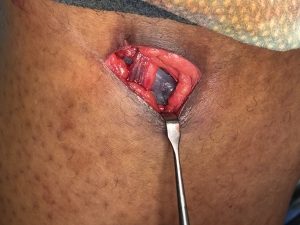 Implants, if properly placed in the gastrocnemius fascia, will not seen at the incision level or near the incision. They must be placed low enough to prevent high riding near the peroneal nerve, which can lead to postoperative compression during knee flexion. (as seen in this picture) Besides good positioning it may be necessary to downsize the impant to ensure safe positioning.
Implants, if properly placed in the gastrocnemius fascia, will not seen at the incision level or near the incision. They must be placed low enough to prevent high riding near the peroneal nerve, which can lead to postoperative compression during knee flexion. (as seen in this picture) Besides good positioning it may be necessary to downsize the impant to ensure safe positioning.